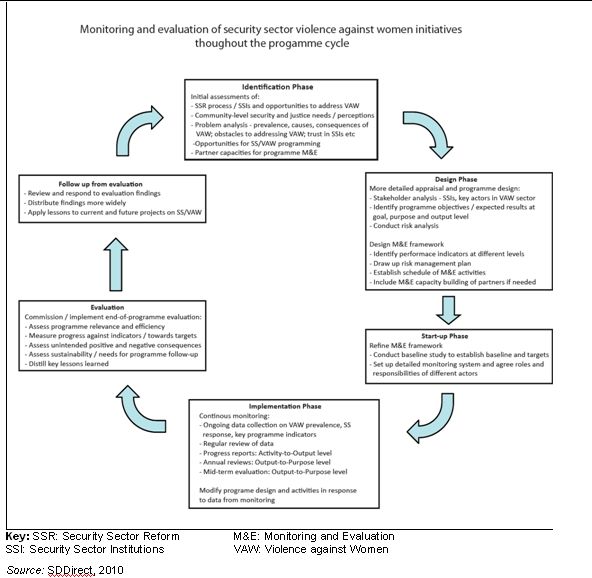-
Monitoring and evaluation needs to be developed during the planning stage and integrated into each subsequent phase of the programme cycle. This ensures that there is clarity about the programme objectives and criteria for measuring success, and that the findings and recommendations of evaluations are used to improve future projects. In addition to providing ongoing assessment of progress against objectives, a well-developed monitoring and evaluation framework or plan allows for adjustments to programme activities based on unforeseeable interruptions and developments or new opportunities.
-
For instance, if a natural disaster occurs, the security sector may be deployed to provide immediate humanitarian assistance or to deal with disaster-related unrest and looting. During such periods, gender-based violence is likely to increase, with different forms emerging or becoming more prevalent (e.g. from predominantly domestic violence to sexual exploitation or disaster-related sexual violence). A monitoring and evaluation plan enables programme objectives and indicators to be adapted in such circumstances without compromising the investments made in the programme and can improve the programme’s contributions to the changing context, risks and priorities while maintaining momentum with respect to its overall objectives.

The content of a monitoring and evaluation plan may vary according to the type of initiative and the format of its conceptual framework (e.g. using a logical framework or results-based structure), but should include the following:
-
Clear framework of objectives/ expected results at activity, output and outcome levels which set out what changes the programme hopes to achieve and how.
-
Well-defined performance indicators for each result, which present how progress will be measured and which key data sources will be tracked.
-
Risk management plan outlining the potential risks to programme implementation (e.g. stalled approval/ commitment from security institutions; delay in adopting operational policies; budget cuts for training) and a process to monitor and respond to these risks (monthly stakeholder meetings; annual workplan reviews).
-
Schedule of monitoring and evaluation activities:
-
What forms of regular monitoring will be done (observation visits to stations; public opinion surveys; focus groups in targeted communities, etc.)?
-
How often will each activity take place (annually, monthly, etc.)?
-
By whom (programme staff, partner organizations, police or military personnel, etc.)?
-
At what level (e.g. activity, output, outcome)?
-
When will the programme be subject to a more formal review or evaluation (mid-term/ endline) and who will conduct this (external team; project staff)?
-
-
A process to review monitoring and evaluation findings – who will review the findings and when (e.g. key ministries and institutional/civil society partners)? How will decisions be made about programme changes and updates made to the logframe or framework of objectives?
Example: Sample monitoring and evaluation matrix template
|
No. |
Indicators |
Indicator Level |
Geographic area |
Baseline measurement |
Target |
Data collection frequency |
Measurement tool |
Remarks |
|
Output 1: Law enforcement agencies adequately prevent and respond to SGBV in the programme's targeted communities |
||||||||
|
1.1 |
Percentage of trained police staff demonstrating knowledge of GBV and response protocols (by sex) |
Output |
District |
No previous training conducted |
75% of male and female trained demonstrate knowledge of GBV and protocols |
Annual |
Pre-post questions and annual follow-up surveys with trainees |
|
|
1.2 |
Percentage of police stations with private places to receive SGBV survivors |
Output |
Community |
20% in 2010 |
50% by end of programme (2014) |
Annual |
Observation visits to station |
Checklist to be developed |
|
1.3 |
Number of GBV awareness activities conducted in villages by police community liaison officers |
Output |
Community |
No previous activities by liaison officers recorded at baseline |
Participation or initiation of at least 1 activity per month |
Bi-monthly |
Reports from partners supporting officers |
|
|
1.4 |
Adoption of policy or procedures by senior police management to increase number of female police |
Output |
District and national |
No policy/ procedures for female recruitment exists at national or district level |
Policy/procedures established and adopted at national/ district levels |
Annual |
Qualitative review of policy context |
conducted during annual stakeholders meeting |
|
1.5 |
Percentage of female officers (out of total police officers) |
Output |
District |
10% of officers are female in 2010 |
15% by end of programme (2014) |
Annual |
Interview with district police commissioner |
|
|
1.6 |
Number of performance audits on police response to GBV |
Output |
District |
N/A |
At least 1 audit is completed by programme end in each target district (2014) |
Mid-term and endline |
Interview/ analysis of reports provided by district police commissioner |
|
(Source: adapted from DFID/ UNIFEM Uganda country programme: Supporting Women’s Engagement in Peace-Building and Preventing Sexual Violence)